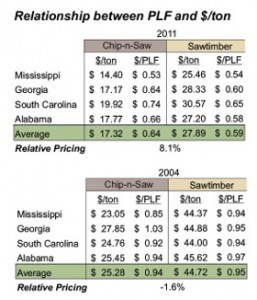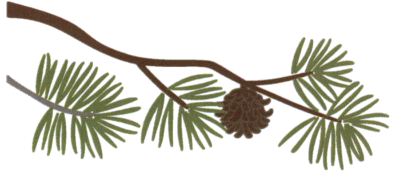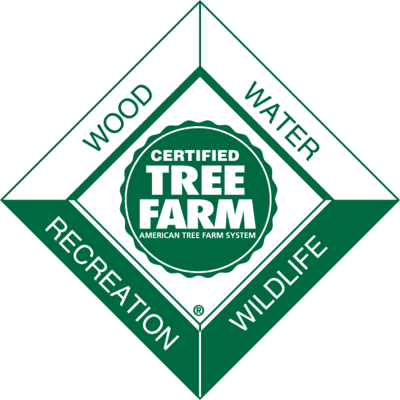Sawtimber vs. Chip-n-Saw
“How big should I let my trees grow?” “Should I let my trees grow for a longer period of time, so I can get a big price?” “How long will it take them to reach sawtimber size?” “Will the market for sawtimber be strong when I am ready to sell?” These questions continue to vex timber land owners.
For the past 11 years, we at Forest2Market have been helping landowners answer these tough questions. Over the first 7 of these years, it was a sure bet that if you let your trees grow into sawtimber, you would receive a higher price for them. Furthermore, if you let them grow into large sawtimber, you would receive an even higher price. In fact, to help landowners understand this relationship, we started measuring price in pounds per linear foot (PLF). Pounds per linear foot is exactly what it sounds like. It is a measure of how many pounds there are in one foot of tree. So, a big tree with a large diameter will have more pounds per foot than a skinny tree. Since a sawmill can cut a wide board (2 x 12) from a big tree, these big trees traditionally commanded larger prices than say, trees from which they could cut just a 2 x 4. From 2000-2007, the market data clearly suggested that larger trees (i.e. sawtimber) commanded a highter price per PLF than smaller trees such as chip-n-saw. As a result, it was easy to advise landowners to grow big trees that commanded both a higher price per ton, but also a higher price per PLF. In 2008, however, the tried and true relationship between the size of the tree and price per PLF started to change. Using the relative measure of PLF, the data now shows that small saw-timber trees (chip-n-saw) are commanding a premium over large sawtimber trees.
Over the first 7 of these years, it was a sure bet that if you let your trees grow into sawtimber, you would receive a higher price for them. Furthermore, if you let them grow into large sawtimber, you would receive an even higher price. In fact, to help landowners understand this relationship, we started measuring price in pounds per linear foot (PLF). Pounds per linear foot is exactly what it sounds like. It is a measure of how many pounds there are in one foot of tree. So, a big tree with a large diameter will have more pounds per foot than a skinny tree. Since a sawmill can cut a wide board (2 x 12) from a big tree, these big trees traditionally commanded larger prices than say, trees from which they could cut just a 2 x 4. From 2000-2007, the market data clearly suggested that larger trees (i.e. sawtimber) commanded a highter price per PLF than smaller trees such as chip-n-saw. As a result, it was easy to advise landowners to grow big trees that commanded both a higher price per ton, but also a higher price per PLF. In 2008, however, the tried and true relationship between the size of the tree and price per PLF started to change. Using the relative measure of PLF, the data now shows that small saw-timber trees (chip-n-saw) are commanding a premium over large sawtimber trees.
 In 2004 (the good old days when timber prices were high), the price per PLF (again, a relative measure) for chip-n-saw was 1.6% below that of sawtimber. This meant that landowners received a premium (on an equivalent basis) for growing larger sawtimber trees. There was a clear financial disincentive to grow smaller chip-n-saw trees. If we take data for 2011, this treend has reversed quite radically. For example, the current data says smaller chip-n-saw trees command an 8% premium over larger sawtimber trees. Could this just be a function of the depressed sawtimber markets due to the poor economy and deplorable housing start numbers? Maybe, but consider the following factors.
In 2004 (the good old days when timber prices were high), the price per PLF (again, a relative measure) for chip-n-saw was 1.6% below that of sawtimber. This meant that landowners received a premium (on an equivalent basis) for growing larger sawtimber trees. There was a clear financial disincentive to grow smaller chip-n-saw trees. If we take data for 2011, this treend has reversed quite radically. For example, the current data says smaller chip-n-saw trees command an 8% premium over larger sawtimber trees. Could this just be a function of the depressed sawtimber markets due to the poor economy and deplorable housing start numbers? Maybe, but consider the following factors.
- Over the last decade, most of the southern plywood plants have closed. This is a structural change in the market, not a short term trend.
- All the technology in the lumber and building products manufacturing is geared toward using smaller trees. Again, the growth in the OSB, MDF, LVL and oriented strand lumber markets is a structural change, not short-term
- Third, the new demand for woodfiber is coming from wood pellet manufacturers and utilities. in both cases, they are using small trees (or even a low grade product).
- Recent reports from Forest2Market’s Mill2Market Lumber Pricing Service showed that 2x4s sold for MORE than 2x12s. So, sawmills are getting paid more to cut 2x4s than they are for a “premium” 2×12. And since 2x4s can be cut from small chip-n-saw logs, sawmills have no incentive to buy or pay a premium for large logs.
Is this a permanent trend or just an aberration due to current market conditions? I am not entirely sure, but the evidence suggests there are many reasons why landoweners should take another look at their timber holding periods in light of the structural changes happening in the market.






Speak Your Mind